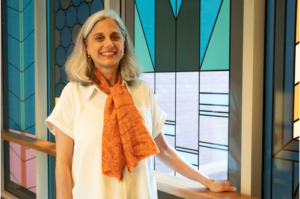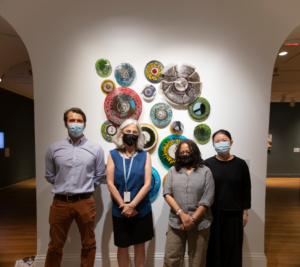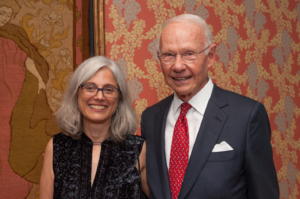Meet our new Chief Curator Elsa Smithgall—who has been part of the Phillips’s curatorial team for 26 years—and hear about her goals for the department.

Elsa Smithgall in front of Airshaft (2021) by Nekisha Durrett. Photo: AK Blythe.
You have been at The Phillips Collection for 26 years. How do you think the Phillips has changed since then? How has the curatorial field changed since then?
The Phillips has indeed changed since I started more than two decades ago. One major change was structural: a major 30,000-square-foot addition in 2006. The new Sant Building created exciting opportunities, including additional galleries for the display of art as well as our first auditorium. Aside from this physical change, some of the most transformational organizational change I’ve witnessed occurred in the past few years in the aftermath of George Floyd’s murder and demands for racial justice. This global racial reckoning has catalyzed museums to center their work on diversity, equity, inclusion, and accessibility. Since our first chief diversity officer came on board in 2018, I have felt the impact of our DEAI initiatives; yet much important work remains. For curatorial, this has led to more interdepartmental collaboration with colleagues as well as with a diverse array of community partners. For example, the Phillips shaped its centennial exhibitions last year in collaboration with a community advisory group while also incorporating community voices in its collection catalogue and wall labels, both models for future projects grounded in a community-centered museum practice.
How will you continue the foundational mission of the museum?
The Phillips was born from our founder’s belief in the necessity of art to promote well-being and connection. That fundamentally remains at the heart of curatorial’s mission: to present, study, and make art accessible to all people, with empathy and inclusion. Today, the museum not only welcomes physical visitors from around the world but also virtual ones, bringing art beyond the walls of its original home at Dupont Circle and our satellite campus in Southeast DC.
Also important, Duncan Phillips aspired for his museum to be a “beneficent force in the community” and had a long history of supporting local living artists. Our latest centennial artist commissions by DC artists Wesley Clark, Nekisha Durrett, Victor Ekpuk, along with last year’s juried invitational for artists of the DC region are just some examples of the ways we seek to play an active role in supporting DC’s vibrant art scene.

Elsa Smithgall with jurors of juried invitational Inside Outside Upside Down.
What are your top priorities as Chief Curator?
In 2020, the museum developed a 5-year strategic and operating plan. As chief curator, my top priorities are to achieve outcomes that advance key strategic initiatives. Some highlights include:
- Build a strong, high-performing curatorial team in a culture of collaboration, belonging, empathy, innovation, and experimentation.
- Grow the collection by adding works that reflect the diversity of our communities and give voice to marginalized figures.
- Stimulate new research and fresh perspectives on our collection that allow us to tell more expansive, inclusive stories about our cultural histories.
- Deepen authentic collaboration with community and academic partners in co-shaping exhibitions, programs, and initiatives.
- Craft a dynamic, innovative exhibition program that supports diverse artistic expressions and invites dialogue about the pressing issues of our day.
- Leverage digital technologies to strengthen visitor engagement through digital storytelling, interactive participation, and online publications.
What is one of your favorite works in the collection that many people may not know about?
There are many, but one I would call out is our gouache by Gwendolyn Knight that she painted during a visit to New Orleans in 1941, following her marriage to Jacob Lawrence. It showcases Knight’s artistic talents in color and design. What I love is the way Knight juxtaposes the larger-than-life red and green blossoming banana flower with the cool geometric buildings, windows, and stairwell and a glistening azure sky. Then upon closer look one notices a silhouetted figure in a red dress cradled beneath the flower. Might that figure represent the artist? Where will her next step take her?

Elsa Smithgall with Roger Sant at the opening of Bonnard to Vuillard. Photo: Rhiannon Newman.
What other favorite work do you have in the collection?
It’s impossible to pick just one out of our nearly 6,000 works today. Not surprisingly some of my enduring favorites are works by artists that I studied at length over the course of exhibition projects. Back in 2002, I had the pleasure of working on a Bonnard exhibition with former senior curator Beth Turner, and then again in 2019 with the Nabi collection of Vicki and Roger Sant which included many works by the French artist. There are many glorious Bonnards among our notable holdings, though I have a soft spot for The Open Window. Bonnard makes us feel as though we are breathing in the scene before that window, moving figuratively between inside and outside. In characteristic form, the artist encourages us to discover activity at the periphery: the woman at far right resting on the chair with a black cat by her side. The shimmering patterns of color give a vitality to the work that has stood the test of time more than a century since its making.

Excellent piece! Thanks Elsa.
Elsa, this is a great introduction to you. I have the benefit of seeing you in thought, in action, and in caring about all of us in the field, pros and non-pros alike. I, and we, look forward to our continued work together, and anticipate continued successes in scholarship and curatorial virtuosity throughout your tenure. Mel